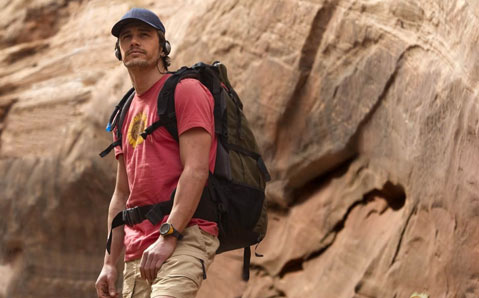127 Hours
James Franco stars in a film written by Simon Beaufoy and Danny Boyle, based on Aron Ralston’s book Between a Rock and a Hard Place, and directed by Boyle.

Feeling acutely trapped in life, in your job, relationship, and/or spiritual/existential bearings, to the point where you contemplate extreme measures for liberation? You may well sense a strong metaphorical resonance in watching Danny Boyle’s gripping new film, 127 Hours, about the true story of weekend adventurer Aron Ralston’s ordeal, trapped for several days deep in a crevasse in Canyonlands, Utah.
Then again, never mind the allegorical aspects: This tale gains much of its power from some cold, hard, concrete facts, made all the more affecting by the veracity of the story. There is a man, a boulder, a hopelessly trapped arm, a diminishing supply of food, water, and hope … and a cheap Chinese-made multi-use tool. And for most of the film’s surprisingly engaging duration, we are trapped along with the hapless but ultimately resourceful protagonist.
Though 127 Hours is being promoted as a film by the man who directed 2008’s Oscar-scooping feel-good hit, Slumdog Millionaire, it’s helpful to remember that Boyle’s filmography also includes the uniquely creepy apocalyptic films 28 Days Later and 28 Weeks Later, the gritty Trainspotting, and the colorful charmer Millions. In Boyle’s latest film, we can see elements of all of the above, with a layered cinematic hyper-style—sometimes to a fault—stirred into the desperation and extreme solution. (Fair warning: The cathartic self-amputation scene may be trying or dizzying for even the most jaded moviegoers.)
Giving the story a human face (and, importantly, human body) is the impressive James Franco, who invests the right amount of emotionality and steely determination as he runs through a gamut of responses to his quandary, ultimately “cutting bait” in a grisly but life-saving, life-affirming way.
This movie takes its place in a small but distinctive genre of films dealing unflinchingly with characters in extremely tight and repressive circumstances, from the great B-movie Inferno to Robert Bresson’s ascetically hypnotic A Man Escaped. Boyle’s entry in the genre, as it happens, lands somewhere between B- and art-movie modes. Go for the symbolic release, or the sharply etched suspense factor, and, most importantly, remember to tell your mother where you’re going if you’re the adventurer sort.



